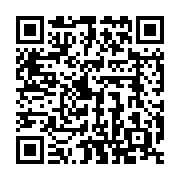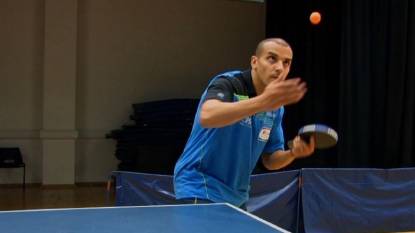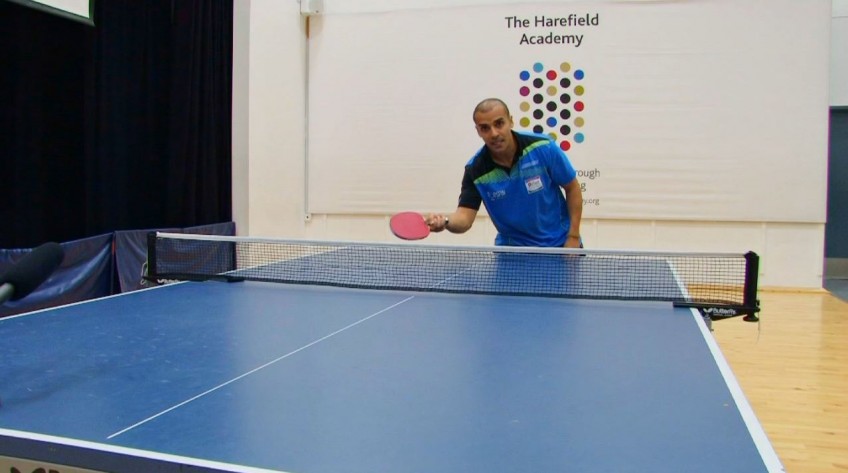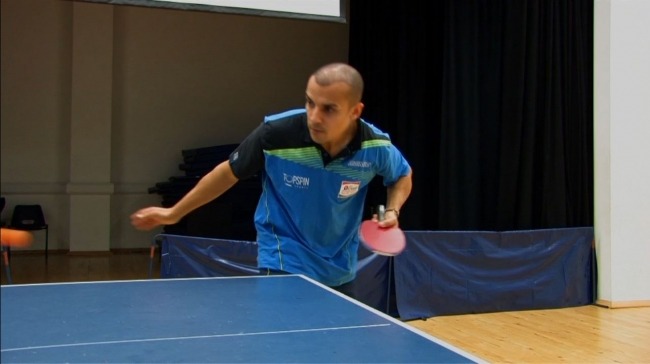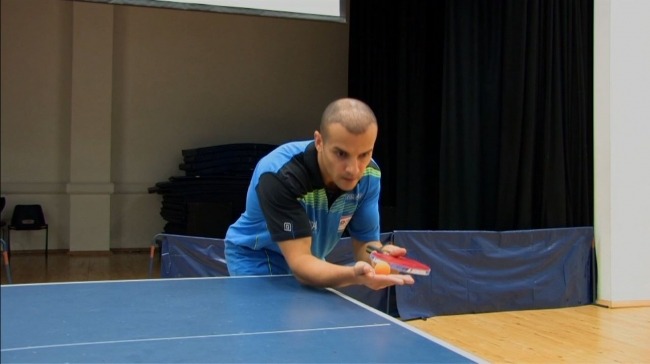Backspin Serve In Table Tennis? The Most Comprehensive How To Guide
By: Mark
November 30, 2020 | Updated: October 22, 2025
As part of our Ping Pong Video Coaching Series, we introduce Eli Baraty a top London coach from The Harefield Academy. Eli has an enormous amount of experience on the UK table tennis scene and professionally coaches many great players.
One of the most effective serves in table tennis which involves imparting a spin on the ball that causes it to bounce backward when it hits the opponent's paddle. This deceptive spin can be highly effective in winning points. In this article, we'll provide a detailed guide on how to execute this serve effectively, along with some additional tips and tricks to take your backspin serve to the next level.
Key Takeaways
- The backspin serve is important for advanced players to master.
- This serve is known by many other names, for example the underspin & chop serve
- Executing the serve requires correct stance, grip, and varying the serve's speed, spin, placement, height, and depth.
- Footwork is essential for executing the backspin serve correctly.
- Effective drills include serving to different areas and incorporating the backspin serve into a combination of serves.
- Opponents can return the backspin serve with a flat paddle or a topspin shot, and players should anticipate and adjust their shot accordingly.
- The right equipment can help generate maximum spin and control.
- Studying top players' techniques and strategies can improve a players' game and success.
Other names for the Backspin / Underspin Serve
In table tennis, the backspin serve, also known as an underspin serve, is a strategic technique that can give players an advantage over their opponents. By generating backspin or underspin on the ball, the server makes it more difficult for the receiver to return the ball aggressively, often forcing them to play a more defensive shot. Here are some of the other names for the backspin serve" and some details on each:
- Underspin serve: This term is used interchangeably with "backspin serve" and refers to the same technique. It emphasizes the downward spin generated on the ball, causing it to stay low after bouncing and reducing the chance of a strong attacking return from the opponent.
- Chopped serve: This name highlights the chopping motion used to generate backspin on the ball during the serve. The racket is angled backward and comes into contact with the ball using a brushing motion, similar to the action of chopping or cutting with a knife.
- Cut serve: Similar to the "chopped serve," the "cut serve" emphasizes the cutting motion used to create backspin on the ball. The server "cuts" underneath the ball with the racket to generate the desired spin.
- Slice serve: The "slice serve" refers to the slicing action used when making contact with the ball during the serve. The racket moves in a slightly diagonal motion, brushing the ball in a way that imparts backspin. This term is often used in other racket sports, such as tennis, to describe shots with a similar spin.
- Reverse spin serve: This moniker might be less commonly used, but it also describes a serve with backspin. The "reverse" aspect of the term refers to the ball's spin direction, which is opposite to the more common topspin or the spin generated when the ball rotates forward.
Each of these terms refers to the same serving technique in table tennis, where the server strikes the ball to generate backspin or underspin. This type of serve can be a valuable weapon in a player's arsenal, as it can limit the opponent's attacking options, create opportunities for the server to attack on the next shot, and add variety to the server's game, keeping the opponent off balance. So for the rest of this article I will use these different names interchangeably.
So What Is The Underspin Serve For?
Ultimately this serve is designed to catch out your opponent so that they cannot return the ball. You will then win the point as they fail to return your excellent serve. The back spin on the ball gives it a kind of backwards force so that when it's traveling through the air forwards, it has a lot of reverse movement just waiting to come out. Once the ball stops or it's hit by the opponent it has a backwards movement to it that is hard to predict, this means that the opponent will likely lose the point.
The underspin serve is a very difficult serve to return and is used by professional and Olympic players all over the world to win points in a match. If you can master this tricky serve, you are well on your way to advancing your game and becoming a great player. In table tennis, having a variety of serves is crucial for winning matches.
Understanding This Serve
The chopped serve is a type of spin serve, also known as a spinny serve or a slice serve. It involves imparting a backspin on the ball, which causes it to slow down and bounce backward when it hits the opponent's paddle. The benefits of using the chopped serve include the ability to deceive your opponent and increase your chances of winning points. It's essential to understand the mechanics of this serve to execute it effectively.
Preparing to Serve
To prepare to cut serve correctly, it's important to have the proper stance, grip, and positioning. Start by standing with your feet shoulder-width apart and your body positioned perpendicular to the table. Hold the racket with a firm but relaxed grip, with your free hand holding the ball. Toss the ball with your free hand, allowing it to drop to your waist level before making contact with the ball using the racket. It's also important to know different table tennis serve techniques to be able to make use of this serve effectively.
Executing the Serve
To execute the reverse spin serve, strike the ball with a brushing motion, imparting a backspin that causes it to bounce backward when it hits your opponent's paddle. The brushing motion involves sliding the racket across the ball in a downward motion, imparting a spin. The amount of spin you put on the ball will depend on the desired effect, but it's important to maintain a firm but relaxed grip on the racket throughout the motion. Follow through with your racket to complete the motion. It's also worth noting that there are different serve variations that you can experiment with to make the serve even more effective.
Tips and Tricks
- To execute the backspin serve effectively, you can experiment with different amounts of spin, placement and angles to make it harder for your opponent to return the ball. You can also try to deceive your opponent by varying the angle or direction of your serve, also known as a deceptive serve. For example, you can serve the ball diagonally to the backhand side of your opponent or serve it straight down the middle. A backhand serve is another type of serve that can be useful in certain situations.
- Another important tip is to practice serving to different areas of the table, this can particularly difficult outside on an outdoor table tennis table. This will help you develop a more well-rounded serve and make it harder for your opponent to predict where the ball will go. You can also experiment with the height of your serve, serving the ball low and close to the net or high and with more arc. This can make it harder for your opponent to return the ball effectively and give you an advantage. By developing a strong service game, you can improve your chances of winning matches.
- It's also important to pay attention to your opponent's body language when serving. If they are leaning forward, they may be anticipating a fast topspin serve, while if they are standing back, they may be expecting this type of serve. By watching their body language, you can adjust your serve accordingly and catch them off guard. This is another aspect of using deceptive serves to your advantage.
- Vary the height and depth of the serve: In addition to varying the speed, spin, and placement of the serve, players can also vary the height and depth of the serve to make it more unpredictable. By serving the ball low and short, players can force opponents to reach forward and potentially make an error. Conversely, by serving the ball deep and high, players can force opponents to back up and potentially lose their balance.
- Practice serving with different equipment: Different types of equipment, such as rubber and blade combinations, can have a significant impact on the spin and speed of the backspin serve. By experimenting with different types of equipment, players can find the combination that works best for their style of play and maximizes the spin and control of their backspin serve.
- Incorporate the backspin serve into a combination of serves: The backspin serve is just one of many serves that advanced players should master. By incorporating the backspin serve into a combination of serves, players can keep opponents guessing and gain an even greater advantage in the game. For example, players can use a backspin serve followed by a topspin serve or a side spin serve, to create a varied and unpredictable serve sequence.
- Watch and learn from top players: Watching videos of top players serving and returning serves can provide valuable insights and tips for improving the underspin serve. By studying the techniques and strategies of top players, players can learn new approaches to this serve and incorporate them into their own game plan.
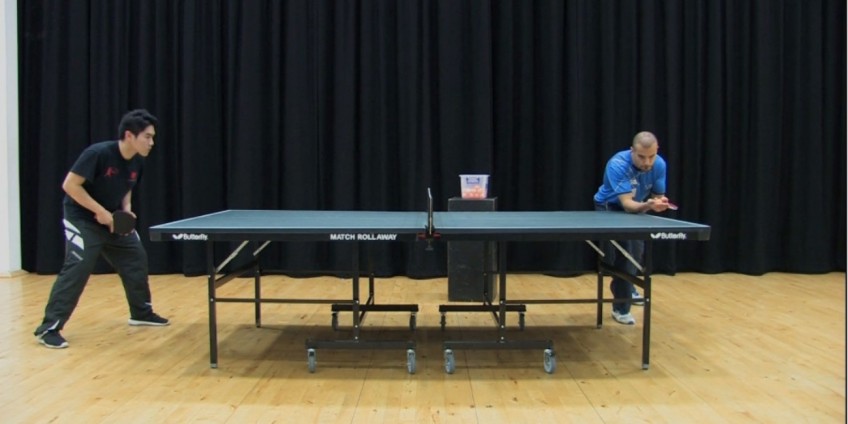
Drills and Practice for the Chop Serve
To master the chop serve, players must practice consistently and hone their skills through drills and exercises.
- One effective drill is to practice serving to different areas of the table, including the corners and the middle. This will help players develop their accuracy and precision.
- Another effective drill is to practice serving at different speeds and with different levels of spin. This will help players develop their control and ability to deceive opponents.
Finally, players should incorporate the backspin serve into their game plan and use it strategically to gain an advantage over opponents. By practicing consistently and developing a solid game plan, players can take their backspin serve to the next level and become more successful in their matches.
Strategies for Returning the Slice Serve
As with any technique, the slice serve can be countered by opponents who are skilled at returning it. Common strategies used by opponents include pushing the ball back with a flat paddle or returning the ball with a topspin shot. To counter these strategies, it is important for players to anticipate the opponent's shot and adjust their own shot accordingly. This requires quick reflexes and a deep understanding of the opponent's game plan.
Players should also be prepared to adapt their game plan if opponents are successfully returning their serves. This may involve using other types of serves or varying the speed and spin of the serve.
Why Does it Work So Well?
The reverse spin serve works so well in table tennis because it creates a lot of spin on the ball that slows down its trajectory and makes it bounce backward when it hits the opponent's paddle. This causes the opponent to have to adjust their swing, timing, and positioning to return the ball effectively, making it more difficult for them to execute a successful return. Additionally, the backspin serve can create a deceptive effect on the ball, making it appear to have less spin than it actually does, leading the opponent to misjudge their return. When used effectively, the reverse spin serve can be a powerful weapon to win points in table tennis.
In Conclusion
The backspin or underspn (or... see other names at the top of this post!) serve is an essential technique for advanced table tennis players to master. By using this serve, players can gain a significant advantage over their opponents and improve their overall game. To execute the serve successfully, players must have the correct stance and grip, generate maximum spin and control, and deceive opponents by varying the speed, spin, placement, height, and depth of the serve. Additionally, players must be prepared to adapt their game plan if opponents successfully return their backspin serve. By practicing consistently, using different equipment, and watching top players, players can take their serve to the next level and become more successful in their matches.
Frequently Asked Questions (FAQ's)
Q1: What is the purpose of the undercut serve in table tennis?
A: The purpose of the backspin serve is to create a lot of spin on the ball that slows down its trajectory and makes it bounce backward when it hits the opponent's paddle. This makes it more difficult for the opponent to return the ball effectively and can create a deceptive effect that leads to misjudged returns.
How do I execute a backspin serve effectively?
To execute a backspin serve effectively, you need to use a brushing motion when striking the ball with your racket, imparting a backspin that causes it to bounce backward when it hits the opponent's paddle. You can experiment with different amounts of spin, placement, and angles to make the serve harder for your opponent to return, and pay attention to their body language to anticipate their return.
Q2: What are some tips for improving my slice serve?
A: Some tips for improving your backspin serve include practicing serving to different areas of the table, experimenting with the height of your serve, and varying the angle or direction of your serve to create a deceptive effect. You can also try different serve variations to make the serve even more effective.
Q3: Is the chop serve legal in table tennis?
A: Yes, the backspin serve is a legal serve in table tennis, as long as it meets the criteria for a legal serve. The serve must start from an open palm and be visible to the opponent at all times, among other requirements.
Q4: How do I return a cut serve?
A: To return a backspin serve, you need to adjust your swing, timing, and positioning to account for the spin on the ball. It's important to read the spin on the ball carefully and adjust your paddle angle and swing accordingly. Practicing returning backspin serves can help you improve your ability to return them effectively.
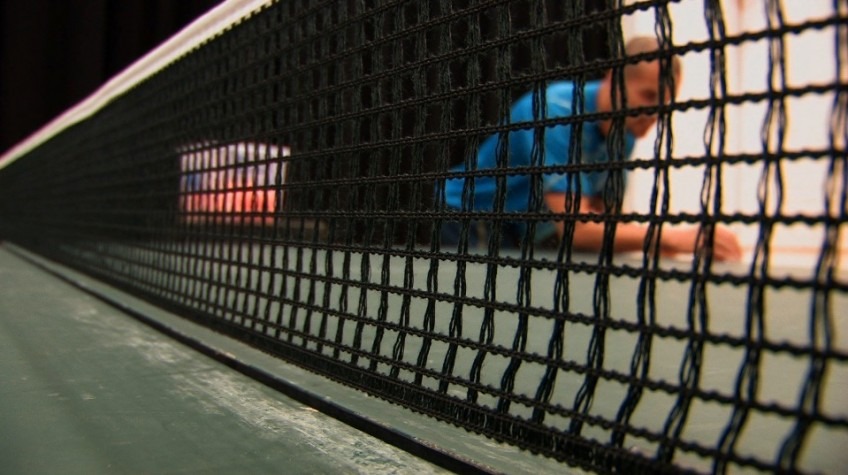
Notable Players Who Use The Underspin Serve
Ma Long
Ma Long is a Chinese table tennis player who is widely regarded as one of the greatest players of all time. Known as "the dragon," Ma Long is known for his powerful forehand and his ability to vary the spin and speed of his serves. He is particularly adept at using the backspin serve to throw off opponents and gain an advantage in matches. Ma Long has won numerous world championships and Olympic gold medals, and he continues to be a dominant force in the sport today.
Jun Mizutani
Jun Mizutani is a Japanese table tennis player who has been playing professionally since 2005. He is known for his quick reflexes and his ability to execute difficult shots with ease. Mizutani is also known for his use of the backspin serve, which he uses to great effect in matches. He is particularly skilled at disguising his serves and keeping opponents guessing. Mizutani has won multiple world championships and has represented Japan at the Olympics multiple times.
Timo Boll
Timo Boll is a German table tennis player who is known for his powerful serves and his aggressive playing style. He is also known for his use of the backspin serve, which he uses to great effect in matches. Boll is particularly skilled at varying the spin and speed of his serves, making it difficult for opponents to return the ball with accuracy. Boll has won multiple world championships and has represented Germany at the Olympics multiple times.
Zhang Jike
Zhang Jike is a Chinese table tennis player who is known for his flashy playing style and his ability to execute difficult shots with ease. He is also known for his use of the backspin serve, which he uses to great effect in matches. Zhang is particularly skilled at disguising his serves and keeping opponents off balance. He has won multiple world championships and Olympic gold medals, and he continues to be a dominant force in the sport today.
Dimitrij Ovtcharov
Dimitrij Ovtcharov is a German table tennis player who is known for his consistency and his ability to execute difficult shots with precision. He is also known for his use of the backspin serve, which he uses to great effect in matches. Ovtcharov is particularly skilled at varying the speed and placement of his serves, making it difficult for opponents to return the ball with accuracy. He has won multiple world championships and has represented Germany at the Olympics multiple times.
Coaching Video
We will be bringing you many more top table tennis techniques from Eli Baraty in this series, so please go ahead and practise each one to master it. So please enjoy this video from Eli Baraty about how to do the serve. Don't forget to check out the Harefield Academy if you are in the UK. If you enjoy this series of top table tennis tips and tricks then please do subscribe to our Youtube channel, follow us on Facebook and Twitter and of course, right here at The Best Table Tennis Tables Reviews.
Video Part 1 Transcription:
To help you progress in your table tennis game, I'm going to show you a few different types of serves.
This includes a very basic backspin serve which means that you will be cutting underneath the ball to get the ball to come back.
And when the person returns it they have to push it. or if it's long they can topspin the ball.
You want to keep the ball short, which means it will bounce twice on the other side.
You want to create as much backspin as possible so that it's difficult for them to flick the ball.
This is how it goes. (demonstration)
You see it's very important to try and keep the serve short, but not too short.
Because if it's too short the players have the angle to hit it wide, or touch it short again.
But if it bounces twice and hits the white line, then the opponent struggles to know whether it's long or short.
Therefore if it's short and it's bounced twice but they think it's long they will hit the bat against the table.
And if they have worked out that it's going to hit the white line then they will come in and touch it but the touch will be here.
Therefore making it very difficult for them to keep it short. Go in long, then you can attack them!
We hope you enjoy this video from Eli Baraty and The Best Table Tennis Tables Reviews, please go ahead and leave a comment!
Backspin Serve In Table Tennis Video Part 1
Video Part 2 transcription
00:00 You want to try and stand on the backhand side predominantly, because you can get your backhand and forehand in a lot easier. Also when you're having your stance you want to have your right leg forward if you're left handing or your left leg foreword if you're left handed, this enables you to twist your body in to the serve gaining more speed and spin.
00:38 The grip, you can have many different variation of the grip, you can hold it loose, you can hold it only with your thumb and finger if you want, or you can full grip it's your choice. You have to try and experiment to find the best solution for yourself. I tend to have a little loose grip, so I can cock my wrist back a little bit more and get as much backspin as possible.
00:58 The last thing I do is, I change my toss, my ball toss, it can go high or low. If it goes high obviously when the ball comes down I get a lot more velocity on the ball gaining more spin and if I chuck it a little bit lower and I gain a little bit less spin and with the same actions. So I get two different serves with two different ball tosses.
01:19 It looks a little bit like this. (Eli serves a couple of times so we can see the examples.) What you can see is. As soon as I've contacted the ball, it travels very low over the net, if you can keep it low over the net, the opponent has to try and kind of scoop the ball up, once they have scooped it up then you're able to get in with an attacking shot.
01:44 The other thing you want to think about which is very very important is where you place the ball. You want to try and place it in three different spots. Short ones and long ones. Therefore the person, if he has a weak backhand and you're serving to the backhand side then hopefully you will get a weak return.
02:00 If they got a strong forehand return and you're serving to the forehand and you're able to serve to the backhand then you can change it and then hopefully get a weaker return.
Backspin serve Coaching Video Part 2
Featured Articles
Dive into in-depth stories, exclusive interviews, and expert advice from the world of table tennis. Discover strategies, player spotlights, and behind-the-scenes insights.

Ping Pong Revolution: How Table Tennis Transforms Homes, Offices, and Communities
Table tennis is uniquely positioned as one of the most versatile recreational activities available today. This comprehensive article explores the transformative impact of ping pong across three …
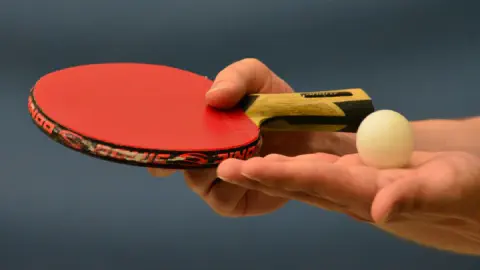
Basic Equipment Needed to Play Table Tennis
What is the basic equipment that you need to get started with playing ping pong? Our guide to the very basic table tennis equipment required to go ahead and start to play. A guide to the basics of …
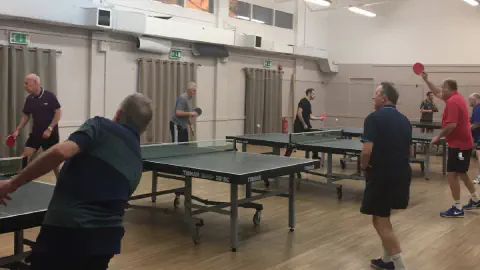
Is Ping Pong Good Exercise? The Top Health Benefits Explained
Table tennis is great exercise both for mind and body. You can use ping pong to keep fit alongside other exercise programs and raise your overall activity levels to lose weight and keep your mind …

Ping Pong Revolution: How Table Tennis Transforms Homes, Offices, and Communities
Table tennis is uniquely positioned as one of the most versatile recreational activities …

Basic Equipment Needed to Play Table Tennis
What is the basic equipment that you need to get started with playing ping pong? Our guide …

Is Ping Pong Good Exercise? The Top Health Benefits Explained
Table tennis is great exercise both for mind and body. You can use ping pong to keep fit …
